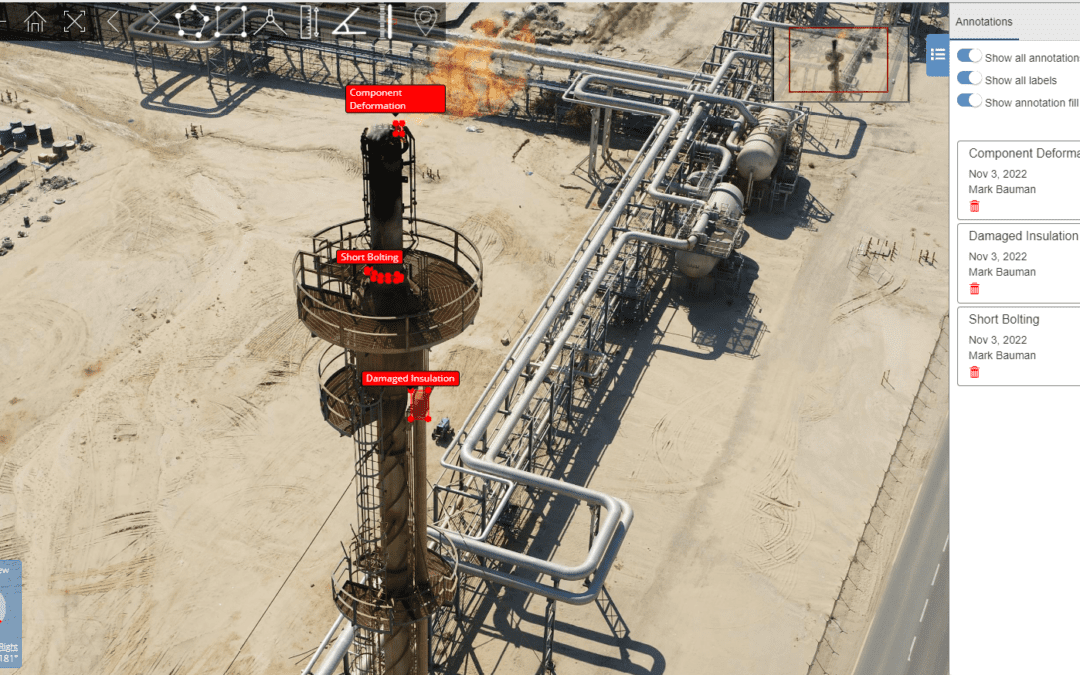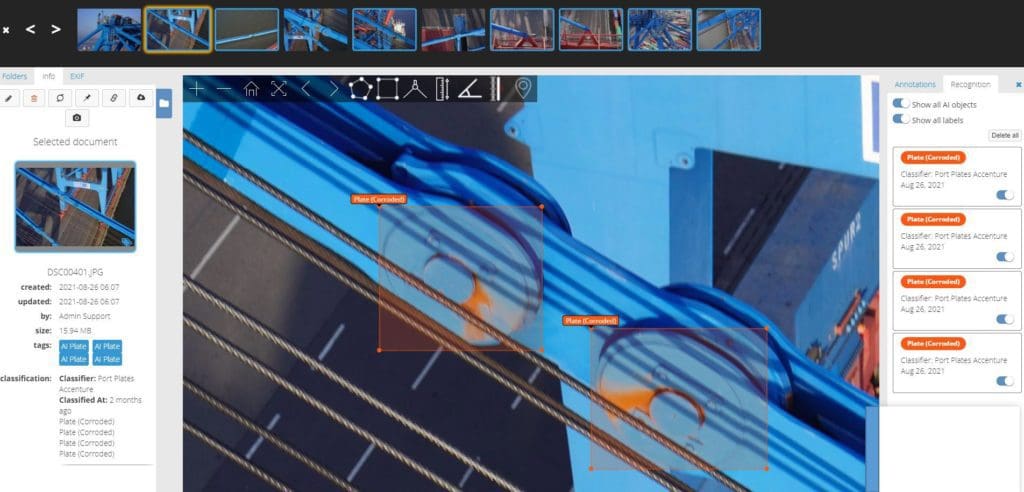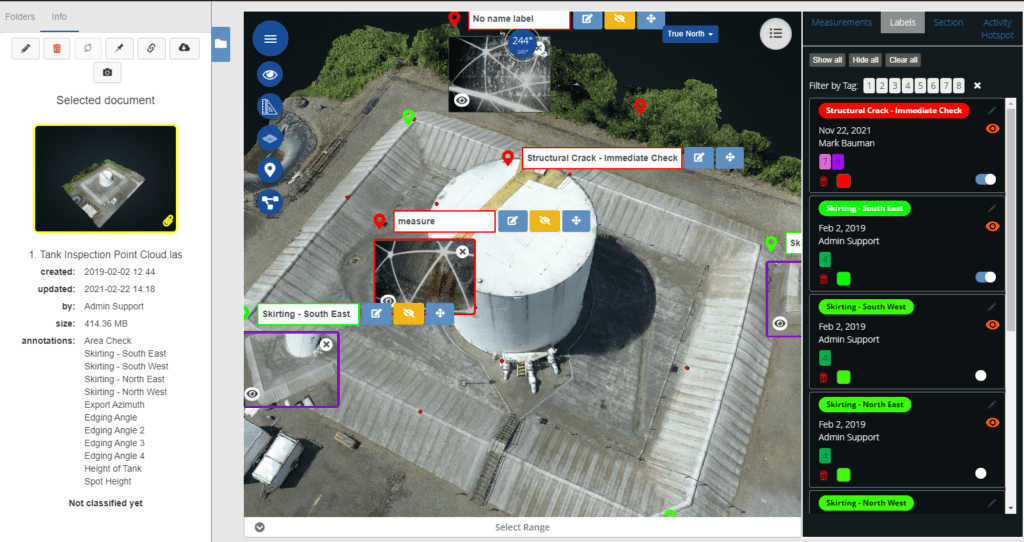In the evolving landscape of the oil and gas sector, operational efficiency and asset reliability have become paramount. As global demand surges and assets age, the industry grapples with challenges that emphasize the need for rigorous, accurate, and timely inspections. Gone are the days when manual checks and paper-based reports sufficed. Today, the industry is at the cusp of a technological transformation, led by oil and gas inspection software that streamlines and simplifies inspections by combining traditional practices with advanced technologies.
But what role does technology play in enhancing these operations? With a myriad of advancements ranging from drone technology to IoT, the modern inspection software doesn’t just detect anomalies; it predicts, analyzes, and even offers solutions. As we dive deeper into this domain, we find that while many solutions claim superiority, Optelos’ Visual Data Management Platform truly stands out, setting a benchmark for excellence and innovation. In this post, we will explore the facets of oil and gas inspections, the transformative power of inspection software, and the new opportunities Optelos is creating in this realm.
Areas of Oil and Gas Operations Requiring Regular Inspection
The oil and gas industry, known for its vast infrastructure and complex operations, demands meticulous attention to detail. Regular inspections aren’t just a procedural requisite; they form the bedrock of safe, efficient, and profitable operations. The consequences of neglecting these inspections can range from operational downtimes to severe environmental and safety hazards. Let’s delve into the core areas of oil and gas inspection programs:
Preventive Maintenance and Its Benefits
Preventive maintenance stands at the forefront of any operational strategy in the oil and gas sector. By conducting regular checks, operators can anticipate and mitigate potential issues before they escalate. This not only prolongs the life of the equipment but also ensures the safety of personnel and the environment.
Regulatory Compliance and the Role of Inspections
The oil and gas sector operates under stringent regulatory norms. These regulations aren’t mere paperwork; they are in place to ensure environmental safety, worker welfare, and operational efficiency. Regular inspections ensure compliance with these norms, reducing the risk of legal complications, and fostering trust with stakeholders.
Key Areas of Focus
Shutdown, TAR Turnaround, and Outage Planning
These are critical phases in the lifecycle of oil and gas operations. It is during these periods that most equipment undergoes inspection, maintenance, or replacement. Proper planning can mean the difference between timely project completion and costly overruns. With proper inspection software, operators can monitor and manage these activities more efficiently.
Corrosion Detection and Facilities Inspections
The very nature of oil and gas operations makes assets susceptible to corrosion. Regular inspections help detect early signs of corrosion, thereby preventing potential leaks or failures. Modern technologies, such as drones and visual AI, have revolutionized this aspect, allowing for more detailed, quicker, and safer inspections.
Automated corrosion detection AI models can be built, trained and deployed with the Optelos platform.
Capital Project Planning
For any new installations or expansions, capital project planning is crucial. Inspections play a vital role in ensuring that the design and construction adhere to industry standards and best practices. Additionally, they help in assessing the feasibility of projects and ensuring they meet safety and efficiency benchmarks.
Regular inspections in these areas not only ensure that the operations run smoothly but also significantly reduce the risks associated with equipment failure or unforeseen challenges. As we navigate through the intricate web of oil and gas operations, it becomes evident that advanced technology is indispensable to gaining efficiency and competitive advantage.
Types of Oil and Gas Inspection Software
The oil and gas industry requires tailored solutions when it comes to inspection software. With the ever-growing demand for accurate, efficient, and quick inspections, the market has seen an influx of a variety of software solutions, each catering to specific needs. Let’s shed light on the diverse types available:
Traditional Inspection Management Software
This type of software serves as the backbone for recording, tracking, and managing inspections. Features often include creating inspection schedules, logging inspection results, and generating compliance reports. While they serve the foundational need, the modern demands of the industry often necessitate more advanced features.
Drone-based Inspection Platforms
Leveraging the prowess of drone technology, these platforms have revolutionized remote inspections. Especially beneficial for hard-to-reach areas like offshore rigs or tall flare stacks, drones capture high-resolution imagery of difficult to reach areas, reducing the need for manually conducting inspections at elevation and thereby minimizing safety risks.
IoT-enabled Inspection Systems
The Internet of Things (IoT) has ushered in a new era of real-time monitoring. Sensors placed on key equipment provide continuous data streams, flagging anomalies instantaneously. These systems allow for proactive maintenance by predicting potential failures or issues before they escalate.
Visual AI Analytics Software
Merging the power of artificial intelligence with visual data, these platforms automatically process and analyze vast amounts of inspection imagery. They can detect issues like pipeline corrosion or equipment wear, often with greater accuracy and efficiency than traditional methods.
3D Digital Twin Modeling
An innovative approach to visualizing assets, 3D digital twins create a virtual replica of the infrastructure. This facilitates precise measurements, virtual walkthroughs, and simulative analysis, proving invaluable for pre-project planning and detailed asset evaluations.
Integrated Inspection Platforms
Optelos stands out as an example of an integrated inspection platform with its expansive visual data management and AI analysi capabilities, with the ability to manage all data types (drone, sensor, CCTV, mobile), develop and deploy AI analytics, and automate the workflow of the inspection data and trouble tickets. From managing visual data from UAVs to operationalizing visual AI for corrosion inspections and creating and analyzing 3D digital twins, an integrated platform like Optelos provides a complete solution for digitally transforming oil and gas inspections.
The selection of a suitable inspection software often hinges on the specific needs of the operation. Whether it’s routine maintenance checks, comprehensive asset evaluations, or predictive analysis, the right software can significantly enhance the accuracy, efficiency, and safety of inspections. With technology advancing at a rapid pace, the future promises even more sophisticated and integrated solutions, and the Optelos platform continues to add new features and functionality to leverage these advacements.
Tank inspection report including hi-res images, LiDAR, thermal sensor data and color-coded annotations to highlight maintenance issues such as insulation damage, leaks, cracks and corrosion.
Why Optelos’ Visual Data Management Platform is the Top Choice
The need for effective visual data management in the oil and gas sector has never been more pronounced. The Optelos visual data management platform rises above the rest, setting new benchmarks in efficiency, accuracy, and innovation. Here’s an exploration of what makes Optelos the preferred choice for oil and gas industry professionals:
Holistic Integration
At its core, Optelos isn’t just an inspection software; it’s an all-encompassing visual data management solution. It smoothly integrates drone data, IoT sensor outputs, 3D Digital Twin models and visual imagery, enabling users to have a comprehensive view of their assets, all from a single platform.
Advanced Visual AI Capabilities
The power of Artificial Intelligence has transformed the inspection landscape. Optelos stands at the forefront of this revolution with its AI-driven analytics. Be it detecting pipeline corrosion or analyzing equipment defect conditions, the platform’s visual AI enables detailed, accurate, and rapid assessments, as well as the ability to train and improve the effectiveness of AI algorithms over time.
3D Digital Twin Modeling
Optelos harnesses the potential of 3D digital twin technology, allowing the creation of precise virtual replicas of infrastructure within the platform. Through the process of photogrammetry, detailed 3D Digital Twin models can be produced, which are useful for conducting remote asset inspections, measuring site areas for equipment placement and spacing verification, asset condition monitoring and even regulatory compliance. Accurate up to 1mm, 3D Digital Twins are used for supporting turnaround activities in the planning phase by reducing the need for onsite planners and return trips for validations.
Streamlined Workflow with Customizable Ticket Routing
Efficiency isn’t just about speed; it’s about process optimization. Optelos understands this, offering customizable ticket routing, prioritization, and assignment. This aligns perfectly with varied organizational structures and workflows, ensuring smooth and efficient task management.
Superior Data Management and Collaboration
A significant challenge in the industry is the organization and sharing of vast geospatial inspection data. Optelos excels in this realm by aggregating and categorizing unstructured visual data into a searchable database. Not only does this facilitate quick data retrieval, but it also promotes enhanced team collaboration, ensuring that critical data is accessible to inspectors, managers, and compliance personnel when needed.
Safety and Cost Efficiency
Adopting Optelos reduces the need for physical inspections in hard-to-reach areas, thanks to drone integration and AI analytics. This diminishes risks associated with manual inspections and leads to cost savings by minimizing the necessity for scaffolding or equipment shutdown.
Reputation and Credibility
The testimony of industry experts, like Grey Johnson, Director of TSG at Legacy PSG, underscores the transformative impact of Optelos. With increased inspection accuracy, efficiency, and data-driven decision-making, Optelos has been a game-changer for numerous organizations.
In the ever-evolving landscape of the oil and gas industry, staying ahead necessitates leveraging the best tools available. Optelos’ Visual Data Management Platform, with its unparalleled capabilities and proven track record, stands out as the most potent choice for organizations aiming to enhance their inspection processes and asset reliability.
Conclusion
In an industry as complex and critical as oil and gas, the need for precision, safety, and efficiency are exceedingly high. Traditional methods of inspection, though tried and tested, often grapple with challenges of scale, cost, safety and environmental considerations. The digital era, led by innovative platforms like Optelos’ visual data management platform, brings forth a compelling solution that provides new capabilities and efficiencies to digitally transform asset inspection and turnaround programs.
But beyond the immediate operational benefits, what Optelos ultimately delivers is a platform that supports the industry’s need for an adaptable, responsive, and future-ready visual data management system. By efficiently managing massive amounts of visual data and large 3D Digital Twin models, Optelos allows enterprises to enhance team colaboration, compliance and facilitate real-time analytics and responses, speeding defect detection and optimzing asset reliability.


